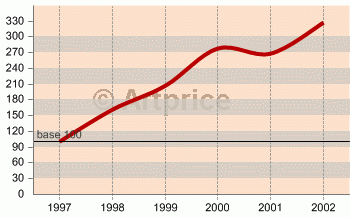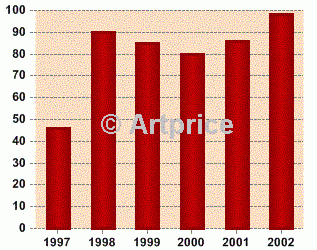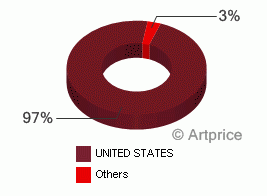Ansel Adams (1902-1984)
[09/07/2003]
A touring exhibition, Ansel Adams at 100, celebrating the centenary of the US photography master, opened in his home town of San Francisco in 2001, and is now showing at the Museum of Modern Art Queens (New-York) until November 2003. Adams is the fifth biggest-selling photographer at auction.
Born in 1902 in San Francisco, Ansel Adams for many years split his life between two passions, the piano — he was a professional pianist from 1925 — and photography. He finally abandoned music for landscape photography under the influence of Albert M. Bender, who published his first collection of photos in 1927, Parmelian Prints of the High Sierra. His subjects of choice were Yosemite and the Sierra Nevada. His famous shots of stark cliffs, waterfalls and winter landscapes were done using his techniques of dodging and burning to correct the unequal contrasts in black and white pictures. The same year he met another great name in photography: Edward Weston. Together, in 1932, they founded the f/64 group, subject of a future show at San Francisco’s DeYoung Museum. The Delphic gallery launched his New York career in 1933. In 1940, he opened the photography department of the MoMA. In 1941 he perfected his zone system that allowed him to work with contrasts and create his distinctive tones. Despite critical success, he had to keep doing commercial work for another thirty years. He sold prints to Kodak, Life, Fortune, etc. This ate into the time he could devote to his creative work. Nonetheless, his landscapes became world famous.
Artworks at auctions
Around a hundred prints come up for auction each year. Of these, some 40% sell for less than USD 5,000, usually small works, printed in large editions, from the later part of his career, generally from the 1960s on. Large formats, small editions from the early years, or better vintages, can go for more than USD 30,000. Among the works commanding the best prices are his many landscapes of New Mexico. At Sotheby’s New York on April 17, 2002, collectors bid USD 74,000 for Aspens, Northern New Mexico (1958), a 76 cm high print and USD 115,000 for a superb 47×61 cm print, made pre-1957, of Moonrise, Hernandez, New Mexico. This trademark image is still his current record. There are a string of later editions (c.1965, c.1978, c.1981) in a 38.5x 49.5 cm format which regularly command USD 20-40,000. Every year half a dozen make it to the auction stand.
The market places
Many of the artist’s photographs were sold by Sotheby’s and Christie’s in the April and October photography auctions in New York. On April 22 and 23, 2003, the two auction houses put up 43 Ansel Easton ADAMS between them. Most of the better works were sold. At the same time, also in the US, the Swan Gallery auctioned a large number of “bargain” prints in 2002, taking advantage of these months of intense auction activity. German auction houses regularly knock down works by Adams at less than EUR 5,000.
Buy or sell
Like many American photographers’ market value, the price index for Adams’s photographs has risen uninterruptedly for the past decade. Recently it exploded. EUR 100 invested in an Adams photograph in 1997 was worth EUR 327 in 2002. And as barely a fifth of lots fail to find buyers, it is hardly surprising that Ansel Adams has the fifth largest turnover of any world photographer, behind Charles Nègre, Man Ray, Andreas Gursky and Thomas Struth. In 1999 he ranked only 13th. Adams is now well established as one of the sure bets in the art market and looks certain to improve his position in terms of turnover in 2003. But, after this rapid rise in price, demand may be stretched and it would not be surprising to see his price index slip somewhat in 2003.
Ansel Easton ADAMSArtprice Indexall media categories, base January 1997 = 100, currency: EUR  Ansel Easton ADAMS Lots sold at auctions
Ansel Easton ADAMS Lots sold at auctions  Ansel Easton ADAMS Auction sales turnover 1999-2002 / weight by country
Ansel Easton ADAMS Auction sales turnover 1999-2002 / weight by country  © Artprice
© Artprice




 0
0
